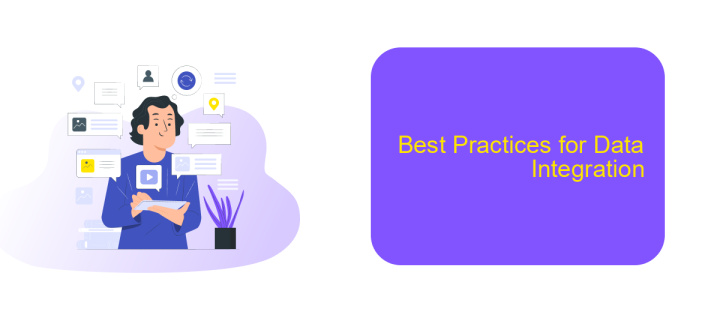Advantages of Data Integration
In today's data-driven world, the seamless integration of data from multiple sources is crucial for businesses seeking to gain a competitive edge. Data integration not only enhances the accuracy and consistency of information but also enables more informed decision-making. This article explores the key advantages of data integration, highlighting how it can drive efficiency, innovation, and strategic growth.
Introduction
In today's data-driven world, the ability to integrate data from various sources is paramount for businesses aiming to gain a competitive edge. Data integration involves combining data from different sources to provide a unified view, which can significantly enhance decision-making processes and operational efficiency.
- Improved Data Accuracy: By consolidating data from multiple sources, businesses can eliminate redundancies and inconsistencies, leading to more accurate data.
- Enhanced Collaboration: Data integration facilitates better collaboration across departments by providing a single source of truth.
- Time and Cost Efficiency: Automating data integration processes can save time and reduce costs associated with manual data handling.
- Better Customer Insights: Integrated data provides a holistic view of customer behavior, enabling more personalized and effective marketing strategies.
One of the tools that can simplify the process of data integration is ApiX-Drive. This service allows businesses to seamlessly connect various applications and automate data workflows, ensuring that data is synchronized and up-to-date. By leveraging such tools, organizations can focus more on strategic initiatives rather than getting bogged down by data management tasks.
Benefits of Data Integration

Data integration offers a multitude of benefits that can significantly enhance business operations. By consolidating data from various sources into a single, unified view, organizations can achieve better accuracy and consistency in their data. This unified data enables more informed decision-making, as it provides a comprehensive perspective that individual data silos cannot offer. Furthermore, integrating data can streamline processes, reducing redundancy and improving efficiency across departments.
One of the key advantages of data integration is the ability to automate workflows and improve data accessibility. Services like ApiX-Drive facilitate seamless integration between different applications and systems, allowing businesses to automate data transfer and synchronization effortlessly. This not only saves time but also minimizes the risk of human error. Additionally, integrated data systems can enhance collaboration among teams by providing a single source of truth, thereby fostering a more data-driven culture within the organization.
Challenges of Data Integration

While data integration offers numerous advantages, it also presents several challenges that organizations must navigate. One of the primary difficulties is ensuring data consistency and accuracy across different systems. Discrepancies in data formats and structures can lead to errors and misinterpretations, complicating the integration process.
- Data Silos: Different departments often use disparate systems, creating isolated data silos that are difficult to integrate.
- Security Concerns: Integrating data from multiple sources increases the risk of data breaches and unauthorized access.
- Scalability: As organizations grow, their data integration needs become more complex, requiring scalable solutions.
- Cost: Implementing and maintaining data integration systems can be expensive, both in terms of financial and human resources.
- Compliance: Ensuring that data integration processes comply with regulations such as GDPR can be challenging.
To address these challenges, services like ApiX-Drive can be instrumental. ApiX-Drive offers automated integration solutions that help streamline data consistency, enhance security, and provide scalable options for growing businesses. By leveraging such tools, organizations can mitigate common data integration issues and focus on deriving actionable insights from their integrated data.
Best Practices for Data Integration

Effective data integration is essential for maximizing the value of your data assets. To achieve seamless integration, it is crucial to follow best practices that ensure data consistency, accuracy, and security. By implementing these practices, organizations can streamline their operations and make more informed decisions.
One of the key best practices is to establish clear objectives and requirements before starting the integration process. Understanding your goals will help in selecting the right tools and methods. Additionally, it is important to choose a reliable data integration platform that supports various data sources and formats. ApiX-Drive, for instance, offers a versatile solution that simplifies the integration process by connecting multiple applications and automating data workflows.
- Define clear integration goals and requirements.
- Choose a reliable data integration platform like ApiX-Drive.
- Ensure data quality and consistency through regular validation.
- Implement robust security measures to protect sensitive data.
- Monitor and maintain integrations to address any issues promptly.
By adhering to these best practices, organizations can ensure that their data integration efforts are efficient, secure, and aligned with their business objectives. Leveraging tools like ApiX-Drive can further enhance the integration process, providing a scalable and user-friendly solution for managing data across multiple systems.


Conclusion
In conclusion, data integration offers numerous advantages that can significantly enhance the efficiency and effectiveness of an organization. By seamlessly combining data from various sources, businesses can gain a comprehensive view of their operations, leading to more informed decision-making and improved strategic planning. The integration process helps in eliminating data silos, ensuring that all departments have access to consistent and accurate information, which in turn fosters better collaboration and communication within the organization.
Moreover, leveraging tools like ApiX-Drive can streamline the data integration process, making it easier and more efficient to connect various applications and services. ApiX-Drive provides a user-friendly platform that allows businesses to automate data transfer and synchronization without the need for extensive technical expertise. This not only saves time and resources but also reduces the risk of errors associated with manual data handling. Ultimately, the adoption of robust data integration solutions can lead to enhanced productivity, better customer insights, and a competitive edge in the market.
FAQ
What is data integration?
What are the main benefits of data integration?
How does data integration improve decision-making?
Can data integration help in real-time data processing?
What tools are available for automating and setting up data integrations?
Time is the most valuable resource in today's business realities. By eliminating the routine from work processes, you will get more opportunities to implement the most daring plans and ideas. Choose – you can continue to waste time, money and nerves on inefficient solutions, or you can use ApiX-Drive, automating work processes and achieving results with minimal investment of money, effort and human resources.

